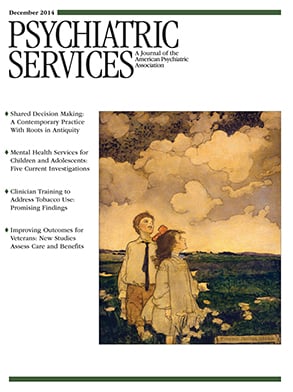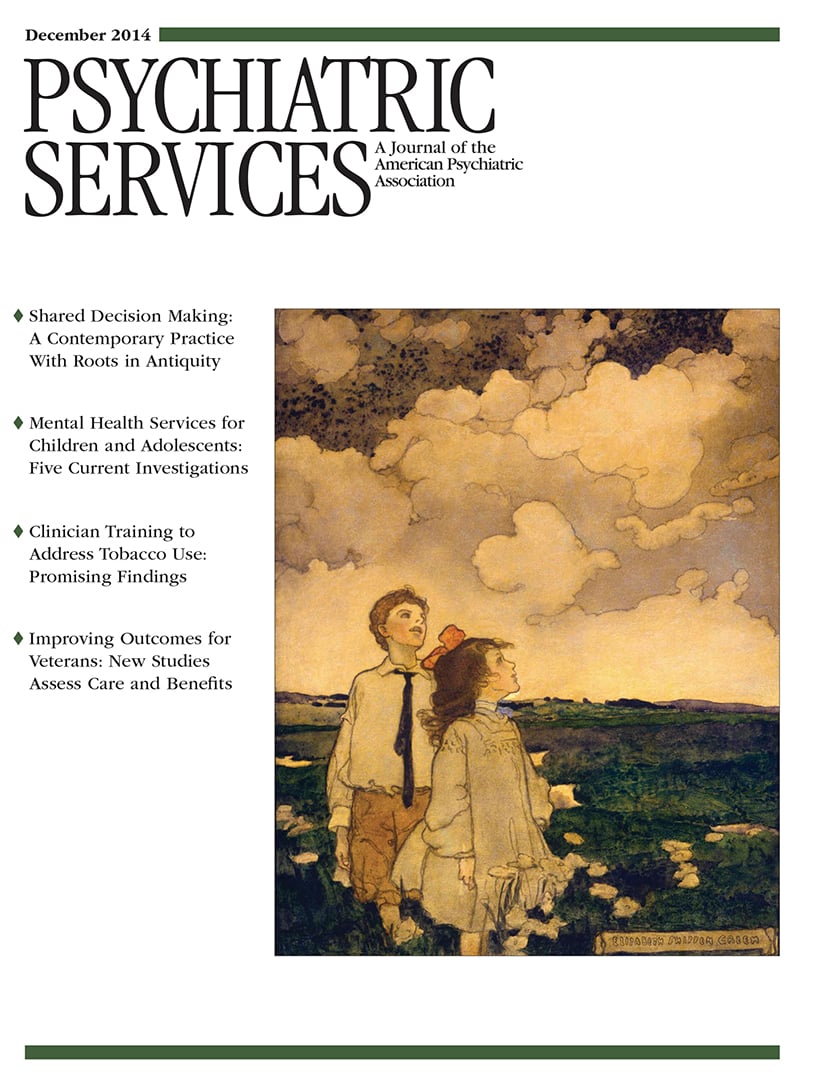Psychiatrists have been considered to be a group that is particularly vulnerable to substance use disorders and mental illness (
1–
3). Although substance abuse in the medical profession as a whole is not greater than in the general population (
4), some medical specialties—including anesthesiology, emergency medicine, surgery, and psychiatry—have been reported to have higher rates compared with other medical specialties (
5–
9). It is difficult to be sure of the validity of these findings because the reported prevalence of substance use disorders within physician specialties varies greatly across studies, and many studies of physician substance abuse have been beset with methodological difficulty (
10), such as the need to rely on self-reported and potentially unreliable data (
11).
The evaluation of physicians entering statewide physician health programs offers an opportunity to gain insight into differences in substance abuse among physician specialties and success rates based on five-year outcomes. Physicians are commonly referred to physician health programs when substance abuse issues become apparent in their professional lives. Evaluations of these programs have demonstrated that physicians who engage in them have high rates of successful treatment, with a reported 75%–90% abstinence rate five years after treatment (
6,
12,
13). However, a difference in substance abuse treatment and physician heath program success rates for psychiatrists has not been evaluated.
In this study, we used data from 16 state physician health programs that monitored physician participants with diagnoses of substance abuse or dependence over five or more years to compare outcomes of psychiatrists and nonpsychiatrist physicians. A secondary aim was to identify rates of relapse, monitoring-program completion, and successful return to clinical practice by the cohort of psychiatrists after the five-year follow-up period.
Methods
We reanalyzed the data set from a five-year, longitudinal, cohort study reported previously, which involved 904 physicians with diagnoses of substance abuse or dependence and consecutively admitted to one of 16 state physician health programs between 1995 and 2001 (
7). The study was approved by the institutional review board of the Treatment Research Institute.
Of the 904 participants in the original study, 42 (5%) were residents, all of whom were excluded from this study. Of the remaining 862 participants, 55 (6%) were psychiatrists. At the time of this study psychiatrists comprised 5.7% of the approximately 718,000 physicians (excluding residents) providing patient care in the United States (
14). Psychiatrists were thus not overrepresented among those participating in physician health programs.
During the study period, 82 of the 862 participants (10%; three psychiatrists and 79 other physicians) moved out of their state program’s jurisdiction. We had no access to any continuing records for those participants; thus they were not included in the analyses for this study, which are based on 780 physicians (N=52 psychiatrists and N=728 other physicians).
SPSS for Windows, version 15, was used for the analyses. Demographic and outcome variables were analyzed with chi square and t test statistics for comparisons of proportions and means, respectively. Univariate odds ratios (ORs) with 95% confidence intervals (CIs) were computed to compare the two physician groups on binomial characteristics and outcomes.
Results
The 780 participants in this study were distributed among the 16 programs that had participated in a survey of 42 physician health programs (
7) so that on average, there were three psychiatrists (range 0–8) and 46 other physicians (range 9–97) per program. Because there was no evidence of clustering by time or program, we compared the 52 psychiatrists and 728 other physicians on a wide range of demographic, substance use, and outcome measures.
Descriptive characteristics of psychiatrists and other physicians are presented in
Table 1. Program enrollees in both groups were typically in their mid-40s, with men constituting the majority of each group. A significantly greater percentage of psychiatrists compared with other physicians were women (31% versus 13%; OR=.3, CI=.2–.6, p=.001). Most physicians in both groups were mandated to participate in the program. According to intake records, 46% of psychiatrists and 38% of other physicians had a history of treatment for substance use when they enrolled in the program.
The two groups did not differ in regard to the primary substance of abuse recorded in their intake records. Forty-four percent of psychiatrists and 50% of the others were enrolled because of alcohol-related problems; 28% of psychiatrists and 35% of the others enrolled due to opioid use. Although psychiatrists were less likely to have a history of intravenous drug use (psychiatrists, 4%; others, 14%), the difference was not statistically significant. At least half of physicians in both groups (psychiatrists, 62%; others, 50%) had been abusing more than one substance immediately before enrollment. The overall pattern of substance abuse before enrollment was not substantially different for psychiatrists compared with their peer physicians.
The psychiatrists and other physicians were compared on the primary outcome measures examined in the original study: positive tests for drugs and alcohol during monitoring, report of physicians to the licensing board, program status at five-year follow-up, occupational status at follow-up, and deaths. The records revealed that 18% (N=9) of psychiatrists had at least one positive test, compared with 22% (N=156) of the other physicians, but this difference was not significant. Similarly, a smaller percentage of psychiatrists (15%, N=8) compared with other physicians (20%, N=147) were reported to their state licensing agencies because of noncompliance with the terms of the physician health program agreement or relapse, but the difference was not statistically significant.
At the end of the five-year follow-up period, 67% (N=35) of psychiatrists and 64% (N=469) of other physicians had completed their contracts and were no longer required to be monitored. About 15% of each group (N=8 psychiatrists; N=119 others) had their contracts extended beyond the initial monitoring period. The reasons for continued monitoring included relapse; failure to comply with requirements, such as group attendance or therapy; or, in some cases, voluntary continuance to help prevent relapse, demonstrate continued recovery to others, or both. Seventeen percent of psychiatrists (N=9) did not complete the program, as did 19% (N=140) of other physicians. These results indicate that psychiatrists were no more or less likely than other physicians to complete the program, to fail to complete it, or to extend the monitoring period beyond the original five years specified in their agreements.
The final outcome examined was the extent to which physicians who had participated in the programs were licensed and practicing medicine at the five-year follow-up. The study found that the proportion of psychiatrists (75%, N=39) continuing their medical practice was not significantly different than that of other physicians (73%, N=532). Nor was there a statistically significant difference between psychiatrists and other physicians in regard to the percentage who had their licenses revoked (psychiatrists, 13%, N=7; other physicians, 11%, N=77).
Discussion and conclusions
This is the first published study examining the outcomes of physician health programs for psychiatrists with substance use disorders. Our main finding was that there were few differences between the psychiatrist group and all other physicians enrolled in the physician health programs on any major clinical or demographic area except for gender, where the psychiatrists were more likely than the other physician groups to be women. This finding is perhaps not surprising, considering that psychiatry has a larger proportion of women in practice compared with other specialties. In addition, there was a nonsignificant trend for greater proportions of the psychiatrists with substance use disorders to abuse sedatives or “other” often-prescribed drugs. This finding may be associated with the higher rate of sedative-hypnotic abuse among women (
15) and the higher prevalence of women in psychiatry, although our data set was not sufficiently large to confirm this. Psychiatrists were also not overrepresented in the total group of physicians. These studies provide evidence that psychiatrists are at no higher risk than other physicians of being referred to physician health programs.
We also wanted to identify rates of relapse, monitoring-program completion, and successful return to clinical practice by the cohort of psychiatrists after the five-year follow-up period. We observed no significant differences in rates of these variables between psychiatrist and nonpsychiatrist cohorts. At least 75% of psychiatrists remained in clinical practice at five years. We are unable to say how effectively the psychiatrists continued to practice, whether they practiced full-time, or what specific interventions, such as the contracts or the fear of a potential loss of medical license, in the physician health programs led to these seemingly positive outcomes.
Our study highlights that psychiatrists with substance use disorders may be successfully rehabilitated if they engage in supportive monitoring programs. This is an important finding that strongly supports the continuation of such programs for psychiatrists, and all physicians, with substance use disorders. As with all substance use disorders, early detection and supportive intervention are important for abstinence and relapse prevention. Unfortunately, stigma, shame, and guilt associated with substance use disorders frequently discourage physicians, including psychiatrists, from seeking care. This study shows that psychiatrists who fully embraced the changes associated with a healthy recovery, such as completing physician health programs, could continue to have careers at five years posttreatment.
It appears that the view that substance use disorders are more prevalent among psychiatrists than other physicians may be unwarranted, given that psychiatrists enter physician health programs no more frequently than other physicians. However, the possibility that psychiatrists are disproportionately more able than other physicians to avoid entering such programs could not be ruled out by this study.
There were a number of limitations of this study. First, the number of psychiatrists involved (N=52) was small, and although a number of variables trended toward significance, the sample size precluded more definite conclusions. Second, the length of time since this study was completed may limit the usefulness of the results some years later. Given that studies addressing these issues are difficult to undertake and that the data gathered were highly sensitive, these results are important and, we believe, valid today because the processes used in physician health programs today are not markedly changed from a decade ago. We found no indication that substance use disorder prevalence among physicians has changed significantly since the data were collected. The data reported in this study came from 16 states, and although similar programs existed in almost all states at the time of the study, we were unable to determine whether these 16 states had physician health programs superior to those in other states. Finally, the study itself involved the collection of data retrospectively, and although this is not ideal, we believe that the clinical and ethical requirements (difficulties associated with examining physician health programs) make a prospective longitudinal study exceedingly difficult to complete.
In conclusion, this study indicated that psychiatrists had five-year outcomes similar to those of other physicians treated in 16 state physician health programs.
Acknowledgments and disclosures
Funding for data collection was received from the Robert Wood Johnson Foundation in the form of an individual award for prior achievements.
Dr. DuPont is vice-president of Bensinger DuPont & Associates and chairman of its subsidiary Prescription Drug Research Center. The other authors report no competing interests.

